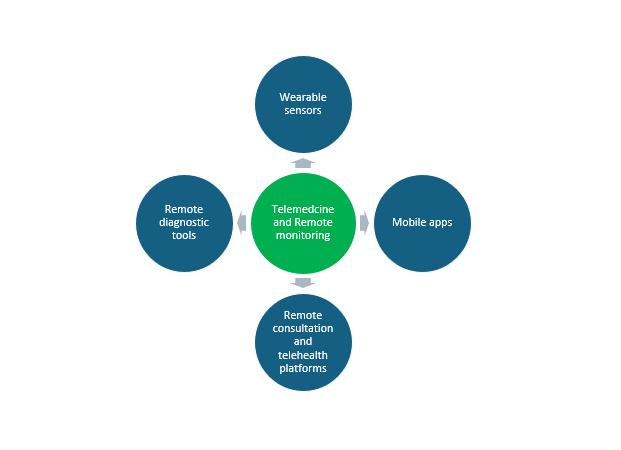Clinical trials are undergoing a paradigm shift from a site-centric or traditional approach wherein the patients are required to go to central sites for consent processes, assessments, and safety monitoring to a ‘decentralized’ or ‘hybrid’ approach in which some or all the trial processes are conducted remotely. The advantages of remote monitoring are several: improved patient convenience due to elimination of travel time to sites, reduced site maintenance or staff costs, better patient adherence to treatment regimen, easier patient recruitment based on elimination of geographical constraints, and improved and wider accessibility to treatments otherwise limited to specific populations.
The COVID-19 pandemic that caused interruptions to trials imposed by travel restrictions and social distancing protocols, increased use and accessibility to mobile technology and digital platforms, and higher patient awareness and education make remote monitoring feasible and applicable to clinical trials. Telemedicine which is the use of electronic information and communications technologies to provide information and support healthcare when distance separates the participants is useful for remote monitoring in clinical research. It provides a platform for healthcare professionals (HCPs) to consult with patients for the diagnosis, treatment, and follow-up and is particularly useful in clinical research as it allows patients ready access to HCPs and is important for safety monitoring.
The applications of telemedicine are broad ranging patient care (radiology, postsurgical monitoring), professional education (continuing medical education, seminars, and training sessions), patient education, clinical research (remote monitoring of patients, aggregation of data from multiple sites in hybrid and decentralized trials), public heath accessibility to remote, rural areas and underprivileged populations, and healthcare administration.
With regards to clinical research, remote monitoring is the central aspect of telemedicine for clinical research applications. By allowing for expanded access to diverse and hard to reach patient populations, telemedicine accelerates trial progression and reduces the time and money required to bring new therapies to the market. Recognizing the widespread accessibility and applicability of telemedicine platforms has led to regulatory agencies drafting guidelines for sponsors/investigators to adopt such that remotely acquired data meets certain standards. The United States Food and Drug Administration (FDA) has released guidances on the use of digital health technologies 9DHTs) for remote data acquisition in clinical investigations and non-invasive remote monitoring. The figure below shows various remote monitoring tools that can be used to monitor patients’ health and conduct virtual consultations.
Wearable sensors
Wearable technologies such as mobile phones, wrist bands, watches, glucose monitors, accelerometers, skin patches, cuffs, finger worn sensors, fitness trackers, etc. collect information about patients’ vital signs or physical activity passively outside of a HCP’s office. This data is transmitted in real-time and in a continuous manner to central databases allowing clinical researchers and HCPs to track patients during the trial process. Wearable sensors are advantageous from a patient perspective as they are convenient by being inobtrusive allowing for better adherence to study protocols and they enable researchers to identify trends and patterns in patients’ health status alerting towards any safety issues in a timely manner.
Mobile apps
The ubiquity of internet connectivity and accessibility and affordability of mobile phones has made mobile health (mHealth) technology readily integrated into clinical research. It enables patients to record symptoms, side effects, and any other data related to study medications into apps available on their mobile phones thereby allowing for real-time entry and improved trackability. This allows researchers to capture data that would otherwise be missed at pre-scheduled site assessments and allows patients to receive reminders and notifications for data entry and medication and appointments reminders. With advances in data analytics, the large volume of data that is captured can be used to tailor patient needs and make changes in future trial protocols.
Remote consultation and telehealth platforms
Virtual appointments with physicians and HCPs via videoconferencing and telephone calls, smartphones, wireless devices and other telecommunications platforms helps in rapid and timely communications and are useful in clinical trials to ensure patients questions and concerns are addressed. This improves patient comfort and adherence to trials in the long term.
Remote diagnostic tools
Telediagnosis enables physicians or HCPs to monitor and diagnose patients remotely allowing for penetration in undeserved areas. Physical examinations records and medical reports as well as information from microscope slides and pathology reports can be transmitted to physicians at the time they become available allowing real-time data availability and diagnosis.
All the above tools form a suite of digital health technology (DHT) that can be used to streamline all steps of clinical trial processes from recruitment to data analysis and are being widely adopted and accepted by regulatory agencies to improve the efficiency and expedite clinical trials. Despite several advantages of remote monitoring platforms, sponsors/investigators still face challenges such as data security concerns and accessibility of technology to all patients for widespread employment of telemedicine. Concerted efforts between patients, sponsors, and regulatory agencies are required to bridge this gap and help realize the full potential of telemedicine in clinical trials.
References
- Introduction and Background – Telemedicine – NCBI Bookshelf (nih.gov)
- Wearable Devices in Clinical Trials: Hype and Hypothesis – PMC (nih.gov)
- Development of a Mobile App for Clinical Research: Challenges and Implications for Investigators – PMC (nih.gov)
- Remote Consultations in General Practice – A Systematic Review – PMC (nih.gov)






